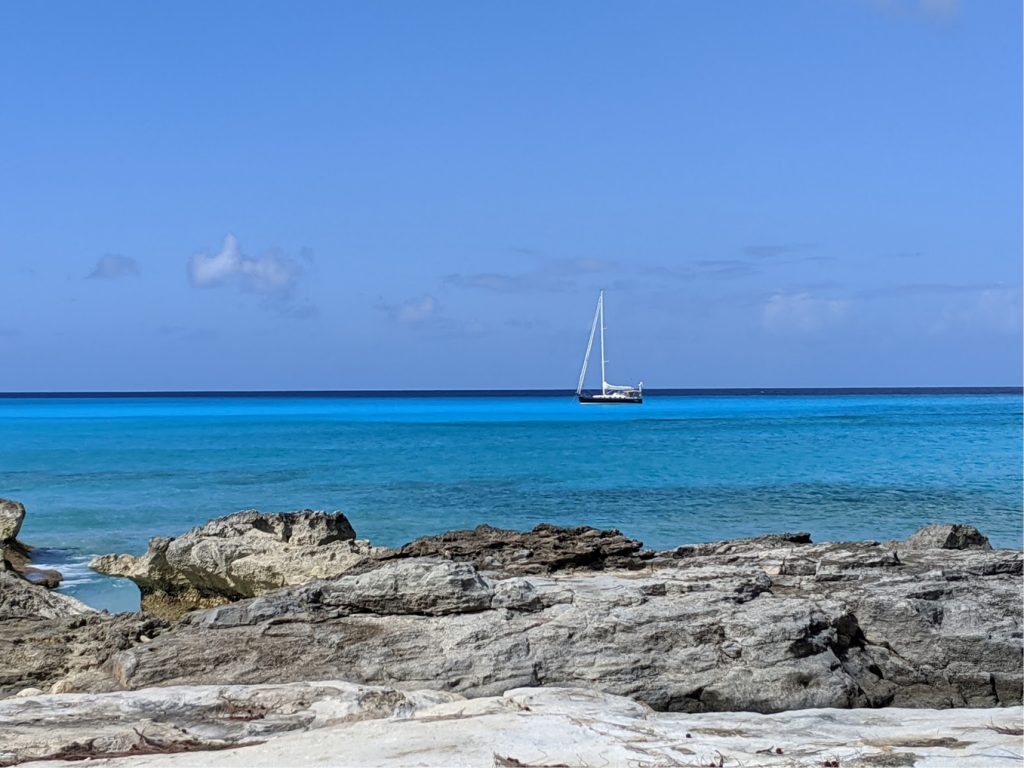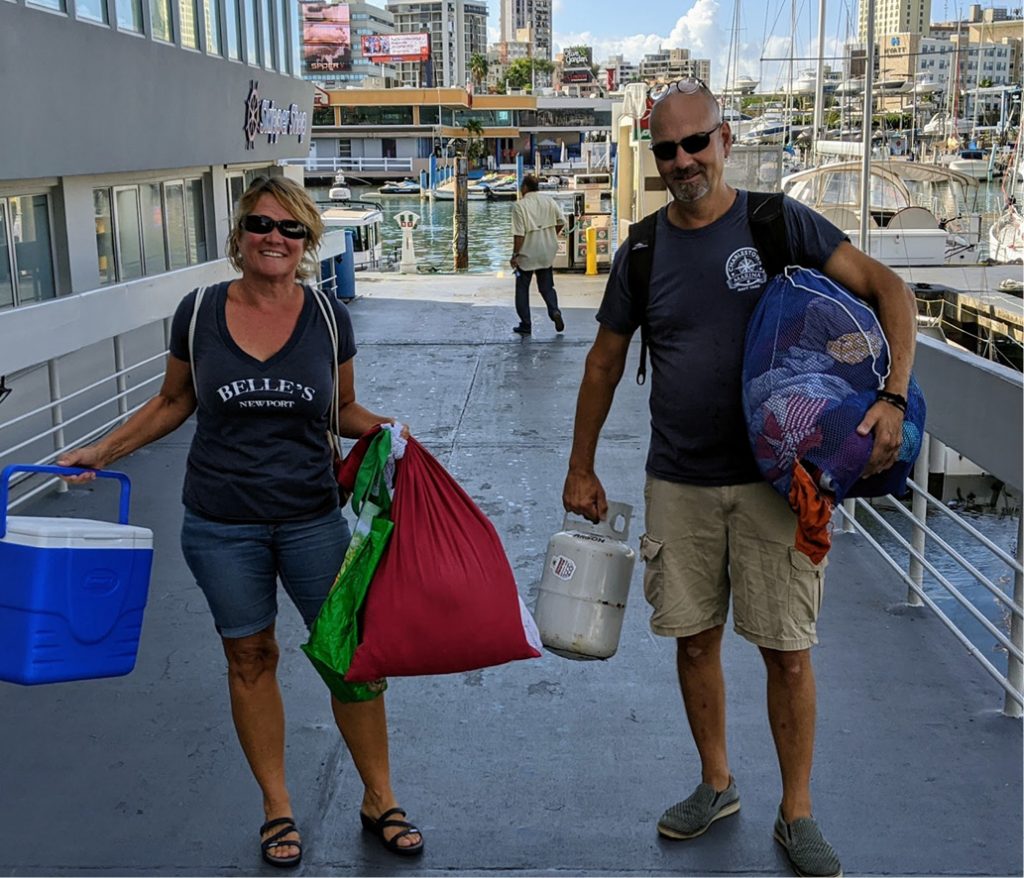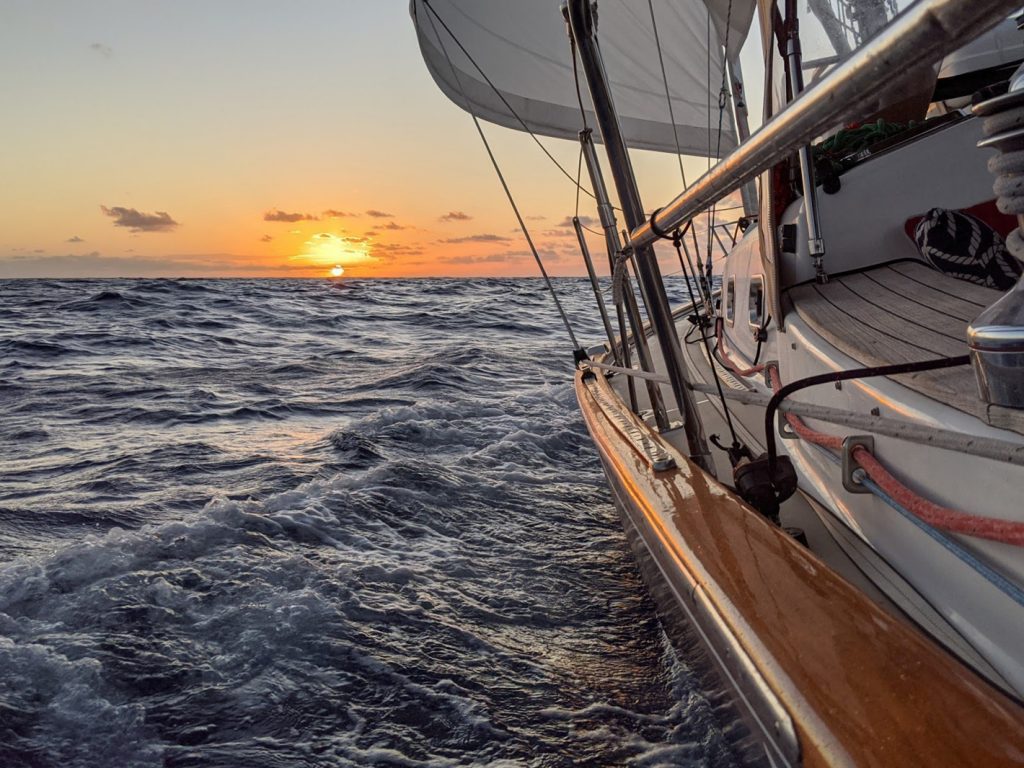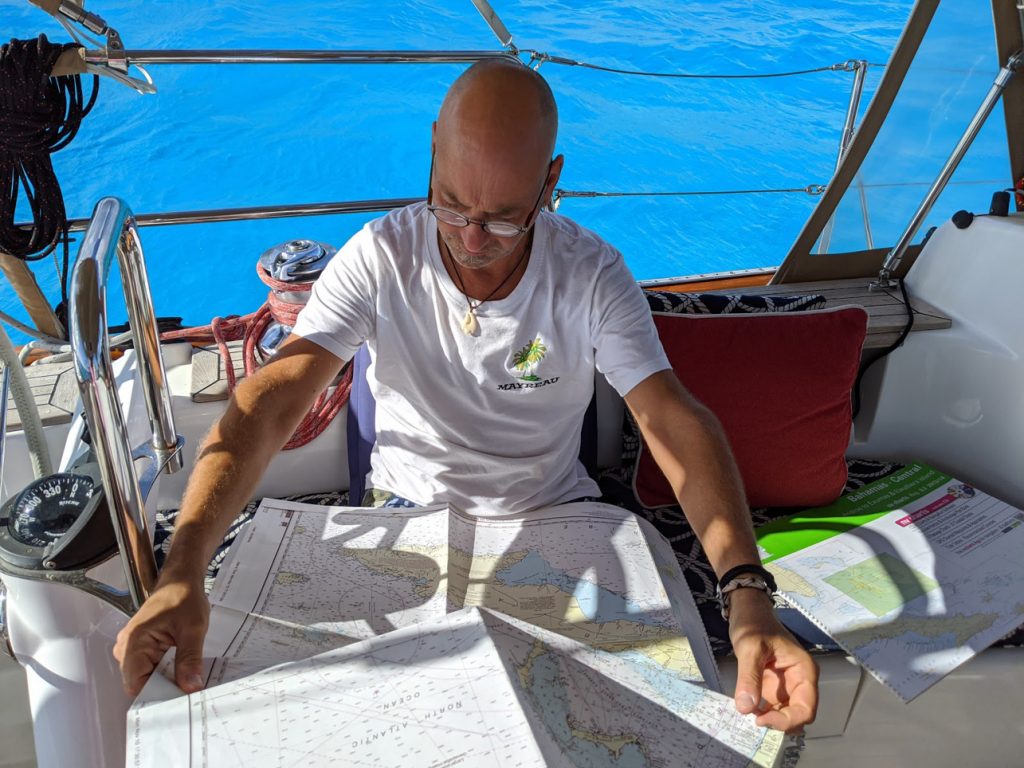By Captain Linda Perry Riera
Editor’s note: This article originally appeared at ArgonSailing.com, an excellent cruising blog produced by Captain Linda Perry Riera and Captain Bob Damiano that documents voyages aboard their Tartan 4000 Argon in New England, the Caribbean and everywhere between.
Argon’s itinerary for spring 2020 had her starting a leisurely month through the Bahamas in April followed by some offshore passages to arrive home in Newport, Rhode Island by early June. Instead, we found ourselves no longer cruising but in delivery mode currently docked in Charleston, South Carolina digging out long sleeve shirts from our closets.

False impression of an idyllic way to self-isolate. © ArgonSailing.com
Some seemed surprised when we recently indicated we were ending our island explorations and accelerating our return to the United States. Proclamations of “Stay where you are!” and “The U.S. is a mess!” were shared by many. I can understand why hanging out on a boat in lovely anchorages surrounded by turquoise water can seem like an ideal way to self-isolate and implement social distancing. However, as the situation started heating up and becoming more serious in mid-March, we very much desired to get home…initially anywhere in the U.S. and then specifically back to the Northeast.
Our main reason for wanting to be home was to be closer and more accessible to our kids and other family and friends. In times of difficulty, one’s nuclear family is paramount. While we had been able to stay in very close contact with our kids, we wanted to be able to get to them quickly should it be needed, to be more accessible to reliable medical care should either of us need it (I know…even that’s at risk.) and also to better able to focus on our jobs. (Oh, jeesh…this is precarious, too.)
As borders began closing, many of our cruising friends found themselves somewhat stuck, unable to freely move about and unsure when they’d be able to return to their homes in Europe, or get out of the hurricane belt. Luckily, we seemed to serendipitously be just ahead of the border closures.
We cut our time short in Puerto Rico as reports of virus spread increased, setting our sights on the Bahamas. The day before departure, we started hearing rumors that Bahamas was closing their borders. However, I could not find anything on line to substantiate. So we left on a three-day passage to the remote island of Inagua (southern Bahamas between Dominican Republic and Cuba) not knowing if we would be allowed in the country.

Within days of our arrival, it became apparent that we needed to set our sights on leaving Puerto Rico, requiring many logistics such as provisioning, laundry and propane, in addition to getting the boat ready for an offshore passage. © ArgonSailing.com
Offshore Passage #1: San Juan, Puerto Rico to Inagua
A veil of worry hung over us during the passage as we wondered how things were evolving back in the states. In addition, we were unsure what to expect when trying to clear customs in the Bahamas.
Upon arrival in Inagua, we lowered the dinghy from the davits and mounted the outboard. I ventured to shore and walked about a mile up the road. The customs and immigration offices were clearly taking the COVID-19 situation seriously, immediately requiring hand sanitation and keeping a clear physical distance. After a detailed health affidavit, the normal boat and crew questions, and $300 for the cruising permit, Argon was cleared into the Bahamas. We were relieved…initially.
Cleared to cruise the Bahamas, we discussed accelerating our travels through the Bahamas making our way from Inagua northward. Bahamas is vast…. Nearly 700 islands and cays sprinkled over a several hundred mile swath of the Atlantic southeast of Florida. Vast areas of extremely shallow waters impede navigation and complicate passages.
But, not so fast… News reports were coming in. Friends immersed in the healthcare system and epidemiological data in Massachusetts specifically and US generally were sharing very concerning information about likely acceleration of infections, probable widespread closures and border restrictions. We were acutely aware of the complications should either of us (which means likely both) become ill with COVID-19 including perhaps being unable to move the boat to a safe location should a difficult weather system approach. And the lack of reliable medical care on these remote islands was worrisome. In addition, these small islands are heavily reliant on their weekly boat deliveries to keep them supplied with basics; one disruption can quickly cause challenges. And we needed to be closer to the kids. We wanted to get home, now even faster than before.
We immediately began to evaluate how we could get to the mainland U.S. more quickly, but safely. First, we seriously considered accelerated day hops northward making our way as fast as possible through the Bahamas up to northern Exumas, then over to the east coast of Florida. But instead, we decided on a faster, albeit more tiring, option of another offshore passage to Florida. We set our sights on a decent weather window opening up in just a couple of days.
Offshore Passage #2: Inagua to West Palm, Florida
Our mindset was now very much on getting home…first to anywhere in the U.S., then to the Northeast. Our cruise was over and we were in delivery mode, but that was OK. There were more important things to focus on.
The front end of this passage was challenging, but conditions eased a couple of days in and we were happy to motor on calm seas the last leg. When we got in to cell data range approaching Miami, we were dismayed to receive reports of south Florida closing up and restricting entry. We were unsure of the best harbor to target and if we would be able to clear customs or be quarantined. Several sailing friends quickly shared information and we decided to target West Palm. There was reason to think that a more northerly port such as St. Augustine would be easier to clear in to, however we were exhausted and thought it unwise to try to continue on for another day and night. West Palm proved to be just fine.

The first night was jaunty but beautiful with a bit of moonlight and starlight. © ArgonSailing.com
Offshore Passage #3: West Palm, Florida to Charleston, South Carolina
Everyday we read the news and examined the epidemiology reports about COVID-19. Our three boys as well as Bob have all had their jobs impacted. Our future daughter-in-law is on the front lines as an ER nurse at a major Boston hospital. Family and friends, well everyone, are all dealing with personal versions of this crisis. We desperately wanted to be home and were making progress, but still felt so far away. We hoped to make it to Beaufort, North Carolina next but the upcoming weather window only allowed us to get to Charleston, South Carolina.
We docked at Charleston City Marina and immediately started thinking and preparing for our next passage. We welcomed the exercise on a one-mile walk to a grocery store to secure more provisions, and visited a local sailing friend who lent us some much needed cold weather gear.
Offshore Passage #4: Charleston, South Carolina to Beaufort, North Carolina
While in Charleston, Bob spent several hours re-examining the depth and bridge data of the Intracoastal Waterway (ICW) to see if there was a segment we could transit, but our mast is just a tad too tall. We reached out to Argon’s builder to confirm the exact specs, and considered climbing up the mast to flip the VHF antennae upside down and remove the tricolor navigation light to cut off several inches. But the measurements remained too close and the thought of the complications should we hit a bridge resulted in us continuing to use the open ocean path.
After much studying of possible inlet options and weather data, we pushed off the dock in Charleston before sunrise and caught an ebbing tide to quickly make our way out to the open Atlantic Ocean for the 225 nautical mile sail to the northeast. We expected a uncomfortable overnight with 15- to 17-knot winds from the northwest. However, the forecast was a bit off in the wrong direction. We were instead rudely greeted by 22- to 28-knot winds with more of a northerly component than westerly, hence way forward of the beam in growing seas. For about five hours starting at 0100 we were getting hammered. Waves jumped over the bow and port side regularly. Initially we sailed with a double-reefed main and just a sliver of jib, but eventually we furled the foresail up completely and motorsailed with just a bit of the main to make better headway towards Beaufort.
By daybreak conditions improved, and even became ideal as if the recent difficulties were just a dream. Or a nightmare. Motoring in to idyllic Beaufort inlet further helped us recover. We were generally confined to the marina in Beaufort with the exception of a walk through town and a cockpit visit with local friends. The town of Beaufort has closed off all incoming roads except for one with a checkpoint to prohibit non-residents from entering. And after a particularly cold night aboard, we were able to borrow a very warm, thick blanket from local friends.
Passage #5: Beaufort, North Carolina to Hampton, Virginia
After just a few days in Beaufort, we departed to take advantage of an acceptable but not quite ideal short weather window for the tricky passage out and around Cape Hatteras. The front end of this passage would have very light winds and flat seas requiring motoring, which at this point neither of us minded. We were in delivery mode and looking to get miles underneath the hull. Then some comfortable sailing with more motoring at the end. However, thunderstorms were also in the forecast and they hit when we were just off Hatteras. Ugh.
As we watched the menacing storm approach from the northwest, we noticed a commercial boat on AIS about seventeen miles to our northwest, likely in the front. Bob radioed the vessel Red Hook and spoke to the captain who was now experiencing our future weather. We were relieved when he said the conditions were moderate with just 20-knot gusts and a little bit of rain. The line of thunderstorms eventually passed over us without too much trouble. There was lightning around, but not too close. Still, it was a relief when we started seeing the lightning on our starboard side going away from us!

Passage planning began after being at anchor only a day or so. © ArgonSailing.com
Closing Argon Up and Heading Home
Many of the marinas and yacht clubs in Virginia and Maryland were now closed to transients. We were able to confirm a slip at Bluewater Marina in Hampton with the caveat that we could either only stay a couple of days, or we could keep the boat there but we could not stay aboard. Nothing personal.
Friends with more sophisticated weather analysis skills as well as our hired weather router all confirmed that there would likely be no acceptable weather window for the 60-hour sail from Hampton to Newport, Rhode Island. We discussed options at length. Stay on the boat and wait (but we would have to find another marina…problematic), or go home with the plan to return in late spring or early summer after the coronavirus situation settles down and weather patterns improve. We decided on the latter. And then we evaluated if we should transit by train, plane or automobile. I’ll spare you the details but for several reasons we returned home by rail.
We had been quite socially isolated those past several weeks, with minimal interaction and contact with others. However we were far from bored as we were extremely busy with passage planning complicated with the evolving coronavirus situation as well as the overall logistics and falling temperatures. The time on passages was mostly filled with either sailing the boat or trying to sleep, given it was just the two of us (these were not relaxing wine and cheese sails). Our social isolation did not involve any binge watching of Netflix, nor playing board games, nor experimenting with exotic dishes, and no Zoom meetups. It was busy and we were exhausted!
Upon arriving at the Amtrak station in Rhode Island, we were greeted by the friendly albeit official National Guard to record our information for the Rhode Island Department of Health and instruct us on a two-week quarantine, which was really just a slightly more strict adherence to social isolation. (The State of Rhode Island was an early adopter of fairly strict guidance and requirements.) It was finally time to check out that Tiger King guy I’d been hearing about. ■
Captain Linda Perry Riera and Captain Bob Damiano are the owners and operators of All Hands Sailing Charters, LLC, based in Newport, RI (allhandssailing.com). You’ll find their beautifully produced YouTube channel at youtube.com/c/argonsailing.
